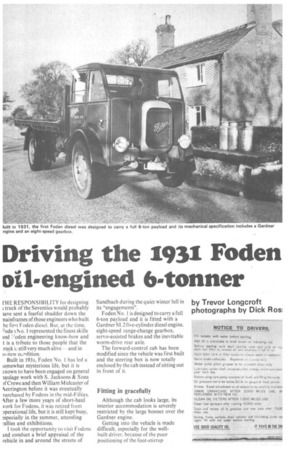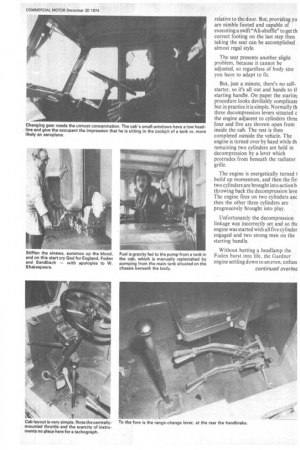Driving the 1931 Foden oil-engined 6-tonner
Page 22

Page 23

Page 24

Page 25

If you've noticed an error in this article please click here to report it so we can fix it.
Il-IE RESPONSIBILITY for designing truck of the Seventies would probably lave sent a fearful shudder down the nainframes of those engineers who built he first Foden diesel. But, at the time. .'ode i No. I represented the finest skills tnd l'oden engineering know-how and t is a tribute to those people that the ruck still very much alive and in is-new cu7dition.
Built in 1931, Foden No. I has led a ;otnewhat mysterious life, but it is cnown to have been engaged on general mulage work with S. Jacksons & Sons )f Crewe and then William Mulcaster of kccrington before it was eventually lurehased by Fodens in the mid-Fifties. kfter a few more years of short-haul uork for Fodens, it was retired from ]perational life, but it is still kept busy, !specially in the summer, attending :allies and exhibitions.
[took the opportunity to visit Fodens Ind conduct a brief appraisal of the vehicle in and around the streets of Sandbach during the quiet winter lull in its "engagements".
Foden No. 1 is designed to carry a full 6-ton payload and it is fitted with a Gardner SI .2 five-cylinder diesel engine, eight-speed range-change gearbox, servo-assisted brakes and the inevitable worm-drive rear axle.
The forward-control cab has been modified since the vehicle was first built and the steering box is now totally enclosed by the cab instead of sitting out in front of it.
Fitting in gracefully
Although the cab looks large, its interior accommodation is severely restricted by the large bonnet over the Gardner engine.
Getting into the vehicle is made difficult, especially for the wellbuilt driver, because of the poor positioning of the foot-stirrup relative to the door. But, providing yo are nimble footed and capable of executing a swift "Ali-shuffle" to get th correct footing on the last step then taking the seat can be accomplished almost regal style.
The seat presents another slight problem, because it cannot be adjusted, so regardless of body size you have to adapt to fit.
But, just a minute, there's no selfstarter, so it's all out and hands to tF starting handle. On paper the startini procedure looks devilishly complicate but in practice it is simple. Normally th three decompression levers situated c the engine adjacent to cylinders three four and five are thrown open from inside the cab. The rest is then completed outside the vehicle. The engine is turned over by hand while th remaining two cylinders are held in decompression by a lever which protrudes from beneath the radiator grille.
The engine is energetically turned build up momentum, and then the fin two cylinders are brought into action b throwing back the decompression leve The engine fires on two cylinders an then the other three cylinders are progressively brought into play.
Unfortunately the decompression linkage was incorrectly set and so the engine was started with all five cylinder engaged and two strong men on the starting handle.
Without batting a headlamp the Foden burst into life, the Gardner engine settling down to an even, unfuss and quiet idle — probably not all that amazing for a Gardner.
Retaking the seat I quickly flicked through the driver's controls, headlight, sidelight, wipers, but what's this? I became flustered, when looking down at my feet, to discover that the throttle had been placed between the clutch and brake pedals. I was assured that for this vehicle the throttle was in the correct position and that once on the road I wouldn't notice anything untoward. The clutch and brake pedals didn't exactly inspire confidence — they sprout from the floor and with their enormous tread plates, about a foot from the floor, they are reminiscent of two hungry antennae searching for food.
I was also filled with trepidation at the thought of completing a range-change using the floor-mounted change lever. Located next to the handbrake, it was a smaller version of it. In the lower position low range was engaged and vice versa.
Contrary to my worst fears, driving Foden No. I is a particularly rewarding experience, especially when the penny drops and instead of attacking the controls with almost Herculean strength one adopts a more subtle approach. Driving the Foden is rather like persuading your wife that it was her idea for you to go to the stag night.
The gearbox layout is that of a conventional four-speed shift and in 1st high the unladen Foden pulled away effortlessly. Changing up required a definite technique and I enjoyed a modicum of success by shifting the gear lever as the clutch pedal was slowly depressed — waiting in neutral for a few seconds until the engine revs had dropped to practically zero, and then executing a smart double shuffle with the clutch and firmly shifting the lever into the appropriate ratio position.
I tried other methods — mostly by accident — and got a sharp indignant growl from the direction of the gearbox.
Changing down needed more expertise and courage and, to be honest, during my spell at the wheel I tried to avoid downchanges unless absolutely necessary. But I did complete one stunning downchange from 4th to 3rd which still leaves me glowing with pride every time I think of it.
As I was assured, the centrally located throttle presented no problems but I try not to think what my reflexes would have made me do if I had been called upon to make an emergency stop.
As the reader has probably gathered, driving the Foden rapidly becomes an enjoyable experience rather than a nagging chore, But, after just a short drive I can easily understand why drivers favour today's vehicle with its luxury cab, constant-mesh if not synchromesh gearbox and by comparison, oodles of power. But early vehicles such as the Foden probably gained more affectionate respect from the driver's than present-day vehicles will ever do.




















































































